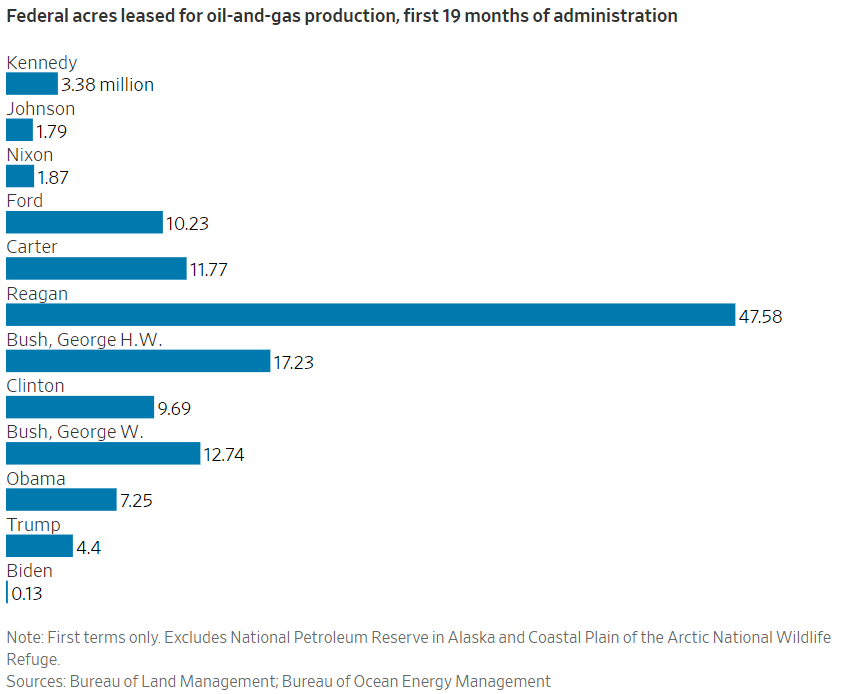Recent claims suggesting that the Biden administration has granted 50 percent more oil and gas drilling permits on federal land compared to the Trump administration have been circulating in the media – and while that data is accurate, it’s a lot more complex. A closer look at the 2023 data reveals that many of the permits approved by the Biden administration were granted on land that was leased during the Trump administration. The Biden administration, on the other hand, has held the absolute minimum lease sales possible.
Viewed in that light, claims of mass permit approval from the Biden administration more accurately describe a time delay in processing the glut of permits pending before the Department of Interior.
Permitting slow among bureaucratic backlogs
Understanding the intricacies of federal land permitting is crucial to understanding permitting data. The multi-year, multi-step process for developing federal land can span several administrations and requires a multitude of different evaluations, approvals, and permitting steps before energy production can even begin.
Based on the federal onshore land development timeline below, it is evident that before entering the permitting phase, there is a comprehensive and lengthy process for pre-leasing and exploration stages. This process, which can take up to a decade to complete, includes in-depth environmental, seismic, and production analyses to ensure viability. Legal challenges from environmental activist groups at nearly every stage of the process can add additional years to the already lengthy process.

At the end of the 2020 fiscal year, right before President Biden took office, a total of 6,234 applications for permit to drill were pending approval. Recent media reports claim that in the last three years, the Biden administration has approved 9,522 permits to drill – which would make up the permit backlog, plus some.
Still, according to the latest BLM data, there are still 5,366 permits currently pending approval before the agency. In part due to the massive slowdown in leasing under the Biden administration, BLM had received a paltry 452 new permit applications year-to-date as of October 2023 – indicating the chilling effect that the bureaucratic slog can have on the industry.
Reminder: one of Biden’s first moves upon taking office was pausing lease sales, resulting in the number of leases for development on federal land slowing down significantly during the Biden administration compared to previous administrations. Delays in sales, ongoing appeals, and settlements with activist groups further contribute to the decline. New Mexico, North Dakota and Colorado have been among the states with lease sales postponed or canceled resulting in a significant economic impact. This impact has affected local and state revenues and budgeting, particularly for these states heavily reliant on oil and gas revenue. Meanwhile, the Biden administration also settled with activist groups and agreed to re-evaluate the National Environmental Policy Act reviews for nearly all of the leases issued under the Trump administration in Wyoming and a significant number across Utah, Colorado, New Mexico and Montana. As the Wyoming Tribune Eagle explains back in 2022 when the news broke:
“None of the leases have been vacated, but their future is uncertain. The Department of the Interior now has to reevaluate and retroactively justify more than two dozen lease sales. If it decides it can’t, or its reasoning doesn’t satisfy the court, the sales could be reversed and any existing permits revoked.”
This ongoing NEPA review has been used as rationale for the Bureau of Land Management failing to authorize Wyoming’s November 2020 leases from the state’s last sale under the Trump administration. For perspective, that’s a nearly $7 million sale that’s been in limbo for more than three years.
The Biden administration’s pace of oil and gas leasing isn’t just slow – it’s the slowest in half a century. A Wall Street Journal analysis of federal acres leased for oil and gas production over the past 50 years revealed that the Biden administration leased a historic low of 0.13 million acres during its first 19 months compared to the 4.4 million acres auctioned for lease during the first year and a half of the Trump presidency.

Source: Wall Street Journal
Similarly, the Biden administration has approved a record low number of new offshore oil wells, according to a recent data analysis by E&E News, in addition to including the lowest number of offshore wells in history in the much-delayed five year offshore leasing program. Despite limited acreage offered during onshore lease sales, industry interest and high-dollar bids persist, underscoring the importance of federal leases to U.S. energy production. Federal lands and waters are responsible for approximately 24 percent of total U.S. oil production.
While the decline in lease sales has not yet caused acute domestic supply issues, it will inevitably affect future production and supply, potentially exacerbating shortages and price surges. This trend not only threatens energy security but also blocks future revenue to federal, state, and local treasuries.
Bottom Line: While we welcome the progress the administration has made in tackling the federal permitting logjam, it’s only one part of the overall story of federal energy production. Mixed messages from the administration – like canceling lease sales one minute and touting approved permits to drill the next – create uncertainty within the energy industry, hindering long-term investments and exacerbating challenges for the United States and the world during a time of geopolitical uncertainty across many regions.
The post Why Biden’s Oil Drilling Permits Surge Is Not What It Seems appeared first on .
This post appeared first on Energy In Depth.
